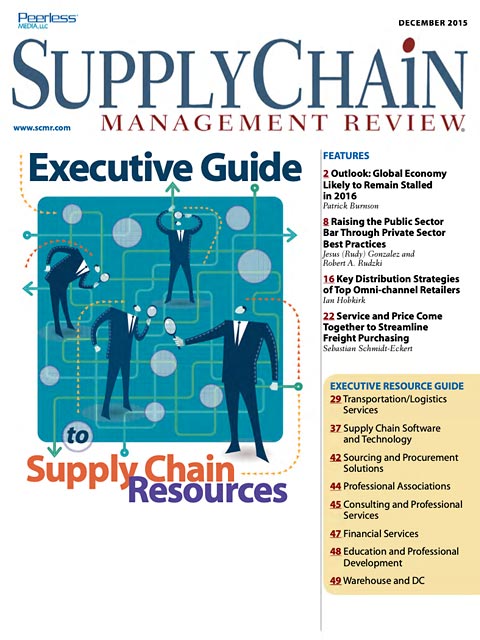Sorry, but your login has failed. Please recheck your login information and resubmit. If your subscription has expired, renew here.
December 2015
It’s December, and time once again for our annual Executive Guide to Supply Chain Resources. This is a comprehensive guide to services, products, and educational opportunities targeted specifically to supply chain professionals. The editors at Supply Chain Management Review wish all of our readers a successful year to come. Browse this issue archive.Need Help? Contact customer service 847-559-7581 More options
BSR (Business for Social Responsibility) is based in San Francisco—one of many port cities vulnerable to high seas and violent storms that may or may not be attributed to climate change. At this year’s annual conference, the need for supply chain resilience was addressed with passion by believers and skeptics alike.
A recent BSR report set the stage for these discussions, and deserves the attention of global supply chain managers and those who rely on their forecasts. Business in a Climate-Constrained World contains vital information on “catalyzing a climate-resilient future through the power of the private sector.” It also represents sound and measured reasoning.
Supply Chain Disruption
Beyond dispute is the fact that dramatic changes in climate pose severe challenges for modes in every transport sector. Analysts note that extreme heat, for example, will soften paved roads, requiring resurfacing with more durable materials. Frequent flooding will require diligent maintenance and investments in a higher, more expensive drainage standard. Bridges will be exposed to surges in water levels, requiring upgraded design specifications in new construction and retrofitting. Estimates range from $140 to $250 billion to adapt existing bridge infrastructure in the United States over the next 50 years.
 |
This complete article is available to subscribers
only. Click on Log In Now at the top of this article for full access. Or, Start your PLUS+ subscription for instant access. |
SC
MR
Sorry, but your login has failed. Please recheck your login information and resubmit. If your subscription has expired, renew here.
December 2015
It’s December, and time once again for our annual Executive Guide to Supply Chain Resources. This is a comprehensive guide to services, products, and educational opportunities targeted specifically to supply chain… Browse this issue archive. Access your online digital edition. Download a PDF file of the December 2015 issue.
 |
Download Article PDF |
BSR (Business for Social Responsibility) is based in San Francisco—one of many port cities vulnerable to high seas and violent storms that may or may not be attributed to climate change. At this year's annual conference, the need for supply chain resilience was addressed with passion by believers and skeptics alike.
A recent BSR report set the stage for these discussions, and deserves the attention of global supply chain managers and those who rely on their forecasts. Business in a Climate-Constrained World contains vital information on “catalyzing a climate-resilient future through the power of the private sector.” It also represents sound and measured reasoning.
Supply Chain Disruption
Beyond dispute is the fact that dramatic changes in climate pose severe challenges for modes in every transport sector. Analysts note that extreme heat, for example, will soften paved roads, requiring resurfacing with more durable materials. Frequent flooding will require diligent maintenance and investments in a higher, more expensive drainage standard. Bridges will be exposed to surges in water levels, requiring upgraded design specifications in new construction and retrofitting. Estimates range from $140 to $250 billion to adapt existing bridge infrastructure in the United States over the next 50 years.
 |
SUBSCRIBERS: Click here to download PDF of the full article. |
SC
MR

Latest Supply Chain News
- Technology’s role in mending supply chain fragility after recent disruptions
- Tech investments bring revenue increases, survey finds
- Survey reveals strategies for addressing supply chain, logistics labor shortages
- Israel, Ukraine aid package to increase pressure on aerospace and defense supply chains
- How CPG brands can deliver on supplier diversity promises
- More News
Latest Podcast

 Explore
Explore
Topics
Latest Supply Chain News
- Technology’s role in mending supply chain fragility after recent disruptions
- Tech investments bring revenue increases, survey finds
- Survey reveals strategies for addressing supply chain, logistics labor shortages
- Israel, Ukraine aid package to increase pressure on aerospace and defense supply chains
- How CPG brands can deliver on supplier diversity promises
- How S&OP provides the answer to in-demand products
- More latest news
Latest Resources

Subscribe

Supply Chain Management Review delivers the best industry content.

Editors’ Picks






